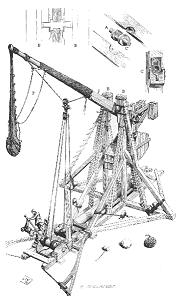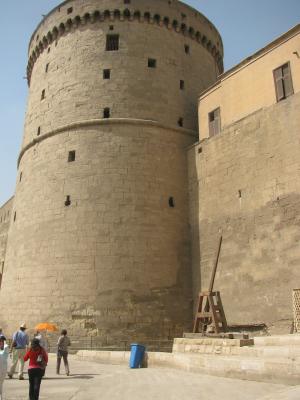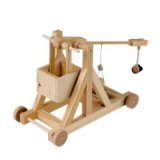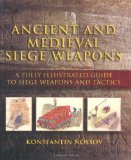 One unusual thing abou the trebuchet is that it is wholly an invention of the medieval period rather than the ancient period. Most other types of siege engines were invented and used in ancient times. The trebuchet first appeard in the medieval period. And it was much needed during this time because castles, castle walls, and fortifications were at this time very strong. Lesser siege engines were ineffective against them. And the trebuchet ruled supreme for a few centuries until it was eventually replaced by gunpowder and cannons. One unusual thing abou the trebuchet is that it is wholly an invention of the medieval period rather than the ancient period. Most other types of siege engines were invented and used in ancient times. The trebuchet first appeard in the medieval period. And it was much needed during this time because castles, castle walls, and fortifications were at this time very strong. Lesser siege engines were ineffective against them. And the trebuchet ruled supreme for a few centuries until it was eventually replaced by gunpowder and cannons.
The trebuchet were formidable against even the strongest fortressess. They could hurl larger stones over longer distances and with tremendous force.
Part of the problem with tracking down early trebuchet use is the muddying of the whole family of siege engines. Often times chroniclers of battles and sieges didn't have any knowledge of siege engines. And this meant that they could be assigned wrong names. It is probably a fact that a chronicler of a battle might make mention of siege engines and catapults yet they were trebuchets rather than catapults and vise versa.
And another reason for difficulty in identifying the use of trebuchets in the middle ages is that they were often referred to as "slingers" because of the long sling attached. But, "Slingers" was a term that also was used to refer to soldiers with slings and it was also given to Mangonels which were catapults that had slings.
There are some possible early mentions of siege engines that could be trebuchets. This includes the Siege of Weissenburg by Otto IV. He used a variety of siege engines including some machines called "Triboke" which were three armed machines thought to be trebuchets.
There are three major things about trebuchets that make them unique. The use of a long throw arm on a pivot, the use of a counterweight and the use of a sling. And the First reliable mentions of these characteristics occurred in the 12th and 13th centuries.
The big thing about the trebuchet that separates it from other siege engies is the use of counterweights which took advantage of the power of gravity and the first reliable mentions of these siege engines started occurring in the 13th century.
Timeline of Sieges and Trebuchets
- 1124 - The Crusaders used great siege engines for the Second Siege of Tyre in Lebanon. It is believed that these great siege engines were counterweight driven trebuchets.
- 1187 - the first pictorial evidence of counterweight driven trebuchets appeared in a military manual written for the military leader Saladin.
- 1191 for the siege of Acre two large trebuchets were used by Philip II
 This picture shows a trebuchet outside the Citadel in Cairo Egypt. I have more about this particular trebuchet right here: This picture shows a trebuchet outside the Citadel in Cairo Egypt. I have more about this particular trebuchet right here:
Trivia - In medieval times armies would sometimes give nick-names to their trebuchets.
The british had a trebuchet nick-named "The Warwolf"
And the Italians had one nicknamed "The Tribute"
Other famous trebuchets from the Middle ages include: The Victorious,The Furious, The Bollocks, "God's Stone Thrower" "Bad Neighbor"

 Backyard Ballistics: Build Potato Cannons, Paper Match Rockets, Cincinnati Fire Kites, Tennis Ball Mortars, and More Dynamite Devices Backyard Ballistics: Build Potato Cannons, Paper Match Rockets, Cincinnati Fire Kites, Tennis Ball Mortars, and More Dynamite Devices Want to get a little more creative? This book is off the hook! Want to get a little more creative? This book is off the hook!
 The Miniature Trebuchet by Timberkits The Miniature Trebuchet by Timberkits
The trebuchet was the ultimate artillery weapon of the medieval period and early renaissance. A large and unwieldy weapon, it was typically built on-site during battle, and tuned to lob great weights - such as the carcasses of rotting horses and pots of burning pitch, over the castle walls and onto its inhabitants. Precision carved by computer controlled machinery for guaranteed fit and accurate joinery. The detailed instructions include loads of photos of each step of the construction process, tuning tips and safety notes. Included in the kit are four wooden projectiles, all the necessary components for the sling, trigger, and counterweight bucket as well as all the parts for the kit. The only thing you'll need to supply are 88 pennies for counterweight and a few simple tools - Scissors, a ruler, a utility knife, wood glue and a few rubber bands to hold the pieces together while the glue dries. Manufactured by RLT Industries
 Ancient and Medieval Siege Weapons: A Fully Illustrated Guide to Siege Weapons and Tactics Ancient and Medieval Siege Weapons: A Fully Illustrated Guide to Siege Weapons and Tactics
There is something alluring about ancient methods of warfare that have been made obsolete by this modern era of computers and machines. Before the days of tanks and machine guns, there were scaling ladders, battering rams, siege towers, throwing machines, bores, and catapults. Weapons such as these symbolize power, protection, control, and defiance.
In the centuries when siege warfare was employed, dominance by any group over a certain area was dependent upon their control over the land. To completely subdue an occupied territory one had to seize every fortress and castle in it. During the medieval period significant advancements were made in siege warfare, weapons, tactics, and stratagems.
In Ancient and Medieval Siege Weapons, author Konstantin Nossov covers the development of all types of weapons that were used in this time period. The tables, charts, and illustrations throughout the book aid the reader in understanding how these weapons were constructed, how they were used, and how they were adjusted to better fit the needs of the warriors.
|
![]()




 This picture shows a trebuchet outside the Citadel in Cairo Egypt. I have more
This picture shows a trebuchet outside the Citadel in Cairo Egypt. I have more 

